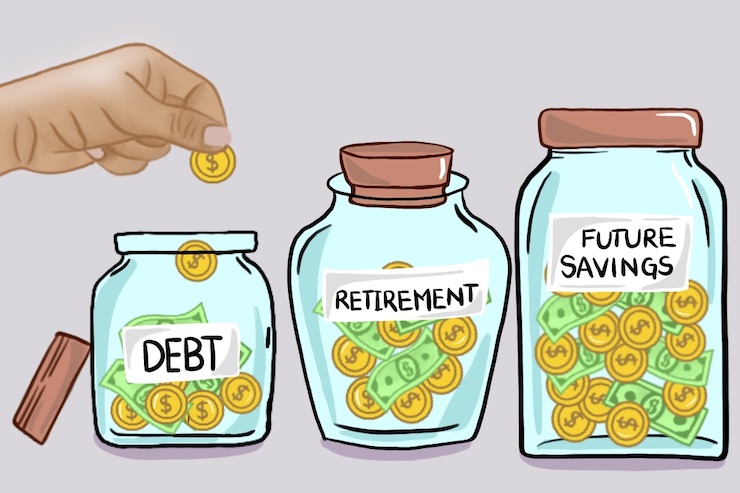The amount of money you need to retire comfortably in Canada depends on a variety of factors, including your desired lifestyle, where you plan to live, your total expenses, and any goals you may have. However, financial advisors often recommend aiming for a retirement income that is about 70% of your pre-retirement income to maintain your standard of living.
For some households, that could mean anywhere from $1 to $2 million. For example, a household that brings in $100,000 per year would need approximately $70,000 per year for 25 years to maintain their lifestyle. That amounts to about $1.75 million for retirement.
When Should You Start To Plan For Retirement?
Planning for retirement is a critical financial goal, and ideally, you should start as early as possible.
Starting to save for retirement early is crucial due to the power of compound interest.
Compound interest is the concept where your investment earns interest, and then that interest also earns interest over time. The earlier you begin saving for retirement, the more time your money has to grow through compounding. Even small contributions made early on can snowball into significant savings over several decades.
By starting early, you can set yourself up for a more financially secure and comfortable retirement, with potentially greater savings accumulated over time.
Why Is It Important To Start Saving Early?
Consider this example.
Two people invest $100 a month at a 5% annual compound rate of return. Person A starts at 25 years old while Person B begins at 35 years old.
By the time both people reach 65 years old, Person A will have saved about $73,000 more money than Person B, despite contributing just $12,000 of their own money. In total, Person A will have $162,000 saved for retirement compared to Person B, who will have only $89,000.
While this might sound extreme, the stock market has a 7% annual compound rate, when adjusted for inflation.
When Do You Plan To Retire?
How much money you will need to retire will ultimately depend on when you are planning to stop working. Determining your retirement age helps establish a more realistic timeline for achieving your financial objectives. People who want to retire early will need to save more money, faster than others. That’s because they are losing valuable contribution years to their retirement fund and will need to support their lifestyle for even longer than a typical retiree.
Key Considerations When Planning For Retirement
- Basic living expenses: Calculate your anticipated expenses for housing, food, utilities, transportation, and other essentials
- Healthcare costs: Factor in costs for health insurance, medications, and potential long-term care needs
- Debts: Aim to pay off major debts like mortgages and loans before retiring to reduce financial burdens
- Income sources: Consider your retirement income sources such as Canada Pension Plan (CPP), Old Age Security (OAS), workplace pensions, Registered Retirement Savings Plans (RRSPs), Tax-Free Savings Accounts (TFSAs), and other investments
- Inflation: Account for inflation when estimating future expenses and adjust your retirement savings accordingly
- Life expectancy: Plan for a retirement that could potentially last several decades, especially considering advances in healthcare and increased life expectancies
- Emergency fund: Set aside funds for unexpected expenses or emergencies during retirement
What Is The Best Way To Save For Retirement In Canada?
The best way to save for retirement in Canada depends on your individual financial situation, goals, and preferences. However, Canadians can take advantage of a few different options and strategies to help them reach their financial goals faster. Below, we’ll go over the benefits of saving for retirement by investing in an RRSP and TFSA account or taking advantage of an employer-sponsored pension plan.
Registered Retirement Savings Plan (RRSP)
RRSPs are one of the most popular retirement savings vehicles in Canada. Contributions to RRSPs are tax-deductible, and investment earnings grow tax-deferred until withdrawal. You can invest in stocks in your RRSP, along with bonds, ETFs, mutual funds, GICs, and more. Withdrawals from RRSPs are taxed as income in retirement.
Tax-Free Savings Account (TFSA)
TFSAs allow you to save and invest money tax-free. Contributions to a TFSA are not tax-deductible, but withdrawals, including investment gains, are tax-free. TFSAs offer flexibility in terms of withdrawals, making them suitable for both short-term and long-term savings goals, including retirement. Buying stocks in your TFSA is a popular way to boost your retirement savings, especially since you won’t have to pay taxes on gains, even when you’re retired.
Employer-Sponsored Pension Plans
Many employers offer pension plans, such as defined benefit plans or defined contribution plans, to help employees save for retirement. Contributions to these plans are often matched or partially matched by the employer, providing a valuable incentive to participate.
How To Sign Up For An RRSP Account In Canada
Today, the best investing apps make it easy to buy the best Canadian stocks in your RRSP account. At Questrade, members can receive up to $50 in free trades just for signing up and starting to save for retirement.
In four easy steps, you can sign up, receive free cash, and start buying the best stocks right now in Canada.
Check out our step-by-step guide on how to buy the best Canadian RRSP stocks right now.
- Click here to sign up for an RRSP account at Questrade
- Fill out the required documents with accurate personal information
- Add funds to your RRSP account
- Receive $50 in free trades to invest in the best RRSP stocks





